Tags
"biology"
Behavioral Neuroscience at the University of Washington: LB Miller, Winter Shadow 2016

One of the pictures I took of glowing antibodies in a brain slice
I can’t say that I ever imagined myself slicing up a brain before junior year of college. A few short weeks ago, I found myself doing just that: turning the huge crank on a deli-slicer-like machine to create a fifty-micron slice of rat brain. I then used an extra fine paintbrush to fish the brain slice out of the negative 22oC resting place and into a room temperature solution that would preserve it for future experiments.
I started high school thinking that psychology was the path for me. Somewhere between the first day of 9th grade and my first day at Reed, I reimagined myself as a rebel who would never follow in their parent’s footsteps. As a freshman I wandered around the philosophy department, and stuck my head in the political science department and finally, with much chagrin, signed up to take intro psychology my sophomore year.
Because I came home to psychology relatively late in my college career, I had to find my way through the department quickly. I had only three years to complete my major requirements, while those who knew what they were about from early freshman year had four. When I found myself enchanted with behavioral neuroscience, I found that I did not have room in my schedule to pursue this interest as well as graduate on time. This is when the winter shadow program appeared in my life and gave me a wonderful opportunity to explore the field of behavioral neuroscience in a hands-on way.
Continue reading Behavioral Neuroscience at the University of Washington: LB Miller, Winter Shadow 2016
LBPA Bacteria Lab at ENS Cachan: Kerry Jones, Winter Shadow 2016
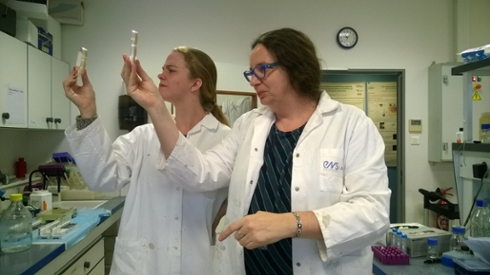
Imagine you’re me. You’re 20 years old and you love DNA, but have very little on your resume to show for it, save a former lab tech job and a prayer that your future employer can detect your enthusiasm. You’re dragging a conspicuously neon suitcase down the street of a Parisian suburb following the signs to École Normale Supérieure de Cachan, a private University with a reputation for its scientific prestige. Not surprisingly, your three days of 1990s-era in-car-insta-French CDs have done nothing to prepare you for the conversation with the security guard explaining what you’re doing there. For the next two weeks, you’ll be having these conversations with everyone you meet by courtesy of the immediate observation that you are out of your element. Your comfort zone is 6667 km away, and you are really excited not to be in it.
For my Winter Shadow Internship, I was working under the supervision of Bianca Sclavi, a biophysicist in charge of the Bacteria Lab at ENS Cachan. Suffice it to say that my Winter Shadow experience was a learning opportunity, but also an experience of exposure on many counts.
LBPA is an interdisciplinary lab, so projects not only pass through the hands of biologists, but chemists, mathematicians, and physicists as well. In addition, Bianca often seeks the assistance of collaborators around the world from Minneapolis to Cambridge to other side of Paris. Coming from Reed, where the Bio Department and the Physics Department ironically feel miles away from one other, this was one of the first surprises about LBPA: how scientific inquiry in its raw form refused to stay in one place. With this in mind, as well as Bianca’s tendency to work on multiple things at once, it was often easiest to follow the development of individual experiments.
Continue reading LBPA Bacteria Lab at ENS Cachan: Kerry Jones, Winter Shadow 2016
Wyle Labs, NASA Ames, Ali Cox, Winter Shadows 2016
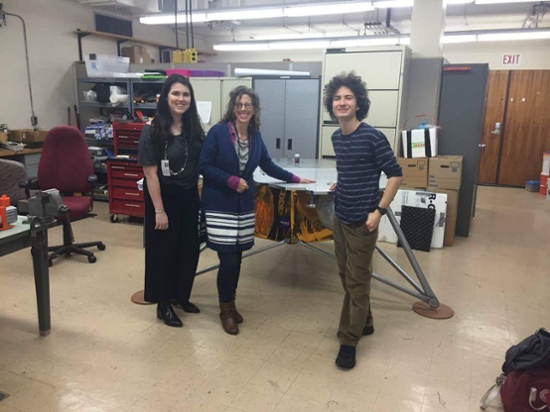
The first day at Nasa Ames Research Center, Arwen showed us her office, where she keeps samples of Mars and Moon dirt analogs (formulated on Earth to resemble as closely as possible the real thing). Apparently these samples are used to test rover instruments to try to determine as best as possible how they would interact with the foreign environment. Arwen also kept pictures of all the previous groups she has worked with on various projects. Among them were a collaboration with the Japanese space agency to build a giant, human-sized centrifuge to simulate the gravity on the moon and on mars, and the construction of the solar panels of the ISS. Arwen showed us a piece of these panels. They were made of an incredibly thin material with intricate circuitry. Apparently when folded the basketball court long panel becomes only 3 inches thick, which I thought was amazing.
After this inspiring first impression of Arwen's job, we attended a meeting on a space station bio-lab Arwen's team is working on. Though there was a lot of technical talk that I didn't understand, I felt the vibe of teamwork and enthusiasm.
Many of Arwen's colleagues work on side projects with a different group of people out of their own interests. One of Arwen's side projects is a new Mars lander whose main goal is to directly search for life using a big drill, unlike previous rovers, which were apparently more concerned with geology. We got to see the life-sized wooden model of this lander built by Dave, a spacecraft expert. Dave was also nice enough to give us a tour of an ancient Titan 1 rocket. He even gave hand-outs about rocket engine principles and the many different types of rocket engines!
Continue reading Wyle Labs, NASA Ames, Ali Cox, Winter Shadows 2016
Presidents Summer Fellowship, Nanofluids and Gene Mapping Part 3, Abrar Abidi

For his President's Summer Fellowship, Abrar Abidi ’16, physics major is working in a lab at McGill University in Canada, helping to develop new nanofluid technology to improve DNA mapping methods. Read on for his third and final blog installment:
Since leaving Montreal at the end of August, I’ve thought back many times to that day I walked through the old city and down to the port. There, in the Fleuve Saint-Laurent, which flows down to the Great Lakes, lies the small Île Sainte-Hélène. And on the other side of this island, half-concealed by a line of trees, is a structure that looks like it came from another planet. Two hundred feet high, and webbed with steel beams and acrylic panels in the shape of a globe, this exotic building disorients anyone that sees it. It is, of course, the Montreal Biosphere, built a half-century ago by Buckminster Fuller for Expo 67, the most successful world’s fair of the 20th century. In its time, when so many countries were riven by wars and paranoia, Expo 67 offered the world a brief remove from the painful past and shameful present—it offered what the world most craved: an optimistic vision for the future.
My grandfather, who died three years ago, was among the 50 million people who attended Expo 67. The son of a radio repairman in India, he grew up in modest circumstances and struggled to secure himself an education at the only university for Muslims in India. He rose, quickly, to the top of his class, and won a scholarship to come to the US where he began graduate studies in civil engineering at Harvard. Soon after his degree my grandfather returned to what was by then Pakistan, where six of his ten siblings shared two small, adjacent rooms. He worked intensely so he could support and provide a good education to his brothers and sisters. That generation of the Abidi family, though small in number now, all went on to find success in their individual careers, and passed on my grandfather’s tradition of hard work and education to the Abidis of my parents’ generation.
Presidents Summer Fellowship, Nanofluids and Gene Mapping Part 2, Abrar Abidi

For his President's Summer Fellowship, Abrar Abidi ’16, physics major is working in a lab at McGill University in Canada, helping to develop new nanofluid technology to improve DNA mapping methods. Read on for his second blog installment:
On so many warm summer evenings here, red and white flares shoot up on the horizon, hissing as they go, before exploding with a deafening pop, forming a lavish spectacle in the Montreal sky. Often as I sit in my little Victorian-era apartment, sudden bangs and crackles send me rushing out to the roof of my building, so I can look toward the harbor, where on an otherwise forlorn stretch of land, six thousand rockets now fire heavenward in a single night. Yearly, the largest firework festival in the world—a kind of pyrotechnic Olympics—takes place in Montreal throughout the month of July. Groups from countries across the world, with their eyes set on prestigious awards, collect in this city to show off their talents in front of three million people. This year, England won the gold medal, while France took home silver and China, bronze. All this amid a procession of other festivities celebrating jazz and African cultures and circus arts and film and comedy. On the few nights not occupied by these events (and we’re still talking only of July), there are huge live music shows, free to the public, many taking place a two-minute walk from my front door.
The lab is a far quieter and colder place. With vents constantly blowing dry, chilly air on every floor of the building, I’ve taken to swaddling myself in at least three layers. Fortunately, the work I do expunges all my guilt for staying indoors. The opportunity to participate in this lab’s experimental efforts is what lured me to McGill in the first place, and in the previous month, my project has taken on a more experimental flavor. Sara, a good friend and researcher with whom I’ve been working closely since June, gave me the task of analyzing thousands of fluorescence microscopy images, zoomed in so close that a fraction of the width of a single human hair could easily eclipse the viewfinder. Fluorescence microscopy is a remarkable technique, where special dyes are used to stain the object of interest, causing it, when illuminated by a powerful lamp, to cast a vivid, luminous glow, no less dazzling to the eyes than the firework displays I can sometimes see from the lab window. Our microscopes are trained on minuscule nano-devices that Sara very cleverly designed and fabricated. Below the glass cover slip, and within these tiny devices, anywhere from a few dozen to several hundred strands of DNA can be seen drifting here and there, tossed about by Brownian motion, flashing like fireflies in the night. Then, with the flip of a switch, the strands rush toward the centers of a series of equidistant spaces, where they accumulate and extend, resembling a phalanx poised for battle. A dial that controls the frequency of a current sent through the device can manipulate their movement, alternately dispersing and concentrating the DNA. The potential applications for this invention are dizzyingly exciting: nothing less than the technology future generations might use to map entire genomes, at speeds and with accuracies far beyond anything currently possible.
Presidents Summer Fellowship, Nanofluids and Gene Mapping, Abrar Abidi
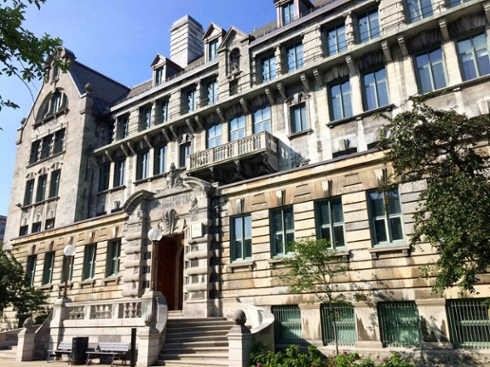
For his President's Summer Fellowship, Abrar Abidi ’16, physics major is working in a lab at McGill University in Canada, helping to develop new nanofluid technology to improve DNA mapping methods.
A chemist who had close friendships with both Albert Einstein and Ernest Rutherford was once asked to share his recollections of the two men. In response, he explained:
“[Einstein] always spoke to me of Rutherford in the highest terms, calling him a second Newton. As scientists the two men were contrasting types—Einstein all calculation, Rutherford all experiment… There was no doubt that as an experimenter Rutherford was a genius, one of the greatest. He worked by intuition and everything he touched turned to gold. He had a sixth sense.”
Winter Fellowship for International Travel: Emmeline Hill
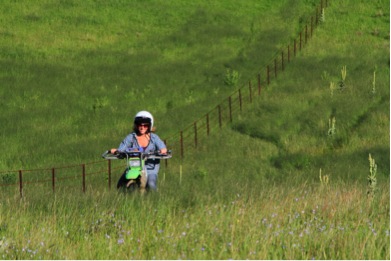
Emmeline Hill, senior biology major, traveled to Australia on a Reed Winter Fellowship for International Travel. The following post describes her experience getting to know the insects and sheep of the island continent.
“You haven’t seen a funnel web yet? Ah, if you like critters, we have to find one. You can just tell they’re predatory when you look at them.”
Thus began my tour through the garden of a friend of my host family on a search for Australia’s most deadly spider. We spent a good 20 minutes tramping barefoot through the dead leaves and branches littering the yard. As we went, Jon turned over various rocks and boards and investigated different crannies, hoping to come upon a funnel web spider. There are several species of funnel webs in Australia, six of which are severely venomous to humans (though there have been no known deaths since the development of an anti-venom in 1981). I’m still not sure if I am disappointed or relieved that no funnel webs decided to make an appearance.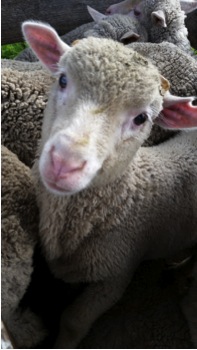
Before I left on my trip, countless people warned me about dangerous spider this and poisonous snake that, don’t go in the ocean and be careful in tall grass. But after a very short time in Australia I learned worrying about every potential threat was a waste of time (though I did check under my bed each night for Huntsman spiders, not because they are dangerous but because I didn’t want to wake up with one on my face). In Australia you don’t run away, you don’t say no because of the vague possibility of danger, you go searching for funnel web spiders, and you poke blue tongued lizards, and you back the truck up to get a second look at the red bellied black snake. I did my best to adopt this philosophy of not saying no. Even when I was exhausted or nervous, if a new opportunity was offered to me, I took it.
For the duration of my trip, I stayed with the Taylor family in the tiny town of Kentucky, New South Wales, on the 1,000-acre sheep farm that has been in the family for six generations. Currently, three generations of family live on the property together, creating a vibrant community of artists, intellectuals, and adventurers, each family member more often than not encompassing all three of those descriptors. I was on the farm as a helper; in exchange for room and board I worked 4-8 hours a day. No two days on the farm were the same, some days I herded sheep from one paddock to another, other days I set to work removing an invasive species of thistle, and sometimes I supervised the kids who almost exclusively wanted to play cards.
Continue reading Winter Fellowship for International Travel: Emmeline Hill
Off Quad Rule: Part 9
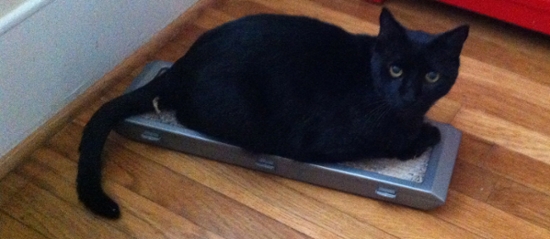
Rooibos
After a week of writing up a precise yet thorough protocol, I am getting to unwind after all the unpacking and driving. It took a few showers and a haircut to really feel like I got that signature ‘wet-lab’ film off, but I am finally back at home grazing and keeping cool.
Continue reading Off Quad Rule: Part 9
Off Quad Rule: Part 8
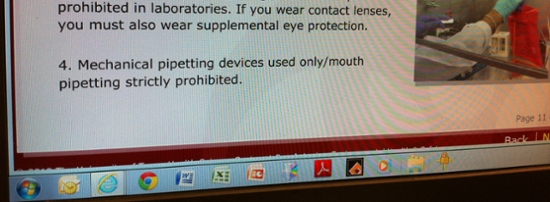
Tehina and Pita
There it is, no mouth pipetting… Sorry Makotes. After a good lab evaluation and fresh samples coming in, the few let downs stemming from the cannabinoid project are hardly felt. At the moment there are some technical difficulties being sorted out since I have been getting a signal of cAMP production when I don’t think I should be. Now I’m investigating a cAMP baseline for the lymphocytes I’m testing for comparison. The good news is that this is somewhat expected since I’ve moved on from the forskolin curve to also running the full agonist drug simultaneously with the forskolin and ATP, a new element to the complicated mix. One step forward, three or five back.
Ful Medames
This week has been super busy, the consequences of the power outage are slowly surfacing as I go about trying to use machines that have switched back to their manufacture default settings. They still work, there’s just a touch more tinkering around that adds up as the day passes along. This week more mouse brain samples arrived for tissue collecting and homogenizing. I finally got a clear picture of them to show you all, the worker making the extractions was excellent.
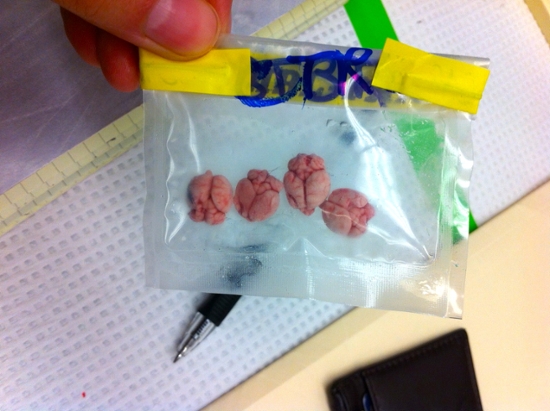 Figure 1. Mouse brains – 4 count. Don’t they look like candy? They’re also hard as rocks from bathing in liquid nitrogen. My thumb for scale, which is already small.
Figure 1. Mouse brains – 4 count. Don’t they look like candy? They’re also hard as rocks from bathing in liquid nitrogen. My thumb for scale, which is already small.
Continue reading Off Quad Rule: Part 8
Off Quad Rule: Part 7
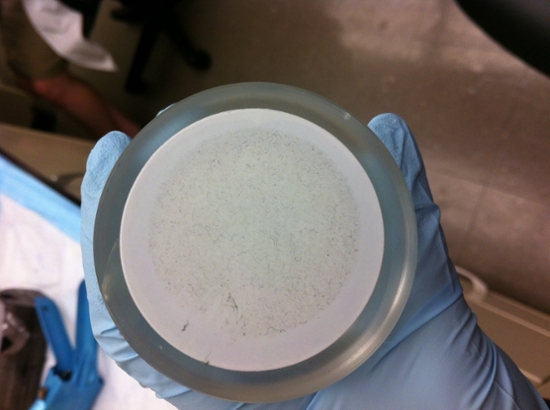
Alecha
The picture to the right is a PSA to remind people to always use protection and filter. Gross, am I right? This week has been filled with me fiddling and peddling around the lab, sometimes in the dark due to the power outage that plagued the research labs and hospital facilities. There is a lab evaluation next week so I won’t have as much time to work on my project and write out as many quick notes and passages to you. It seems that when you need everything to work perfectly it breaks down and throws a tantrum. The HPLC and GC-MS, gas chromatography mass spec, machines are having quite a fit. It’s like the power outage woke up a bunch of cranky toddlers, and believe me, dear reader, they are not crib happy.
Continue reading Off Quad Rule: Part 7
Off Quad Rule: Part 6
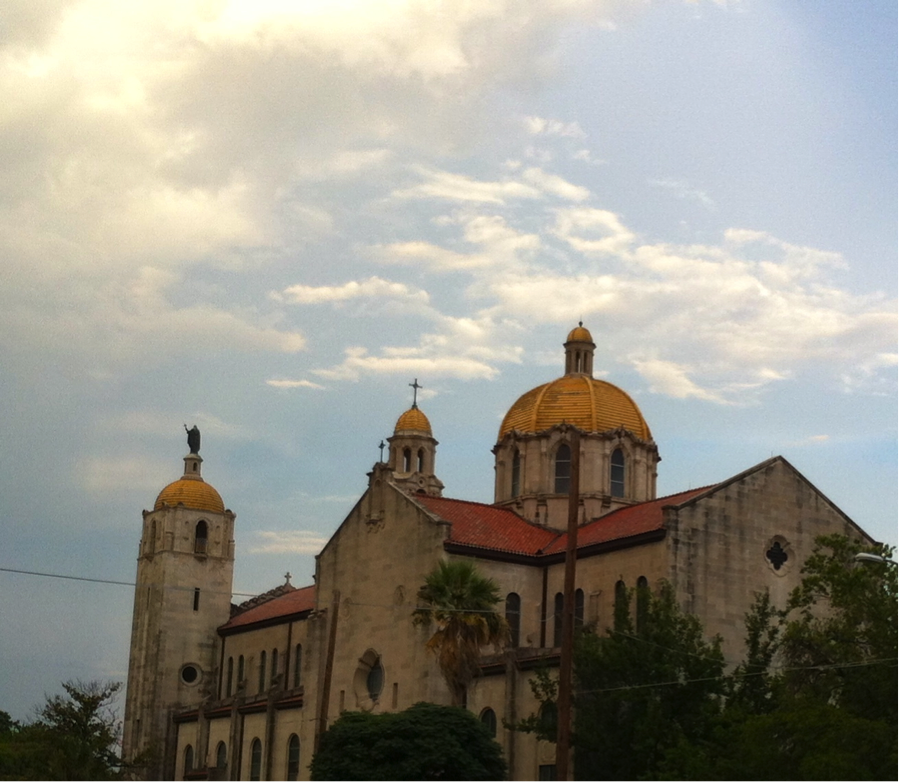
Handkäse mit Musik
Pictured here is La Pequeña Flora, The Little Flower. It’s a church tucked away in a residential area that I happened upon. There are tons of old religious structures in San Antonio, I thought I would share my favorite one with you guys. Touring this was better than seeing the Alamo in my opinion. This week was quite eventful, with a human brain dissection and the chemicals for the ELISA kit I’m working on coming in. I also want to give a huge thank you to all of you sending me letters, the mailman here now knows me by my name due to the abnormal volume of mail I receive that isn’t just bills. As I finish off the final steps in the newest protocol (fingers-crossed) I wish the rest of you much luck with the projects and endeavors you’re tackling this summer. Let’s go Deutschland.
Continue reading Off Quad Rule: Part 6
Off Quad Rule: Part 5
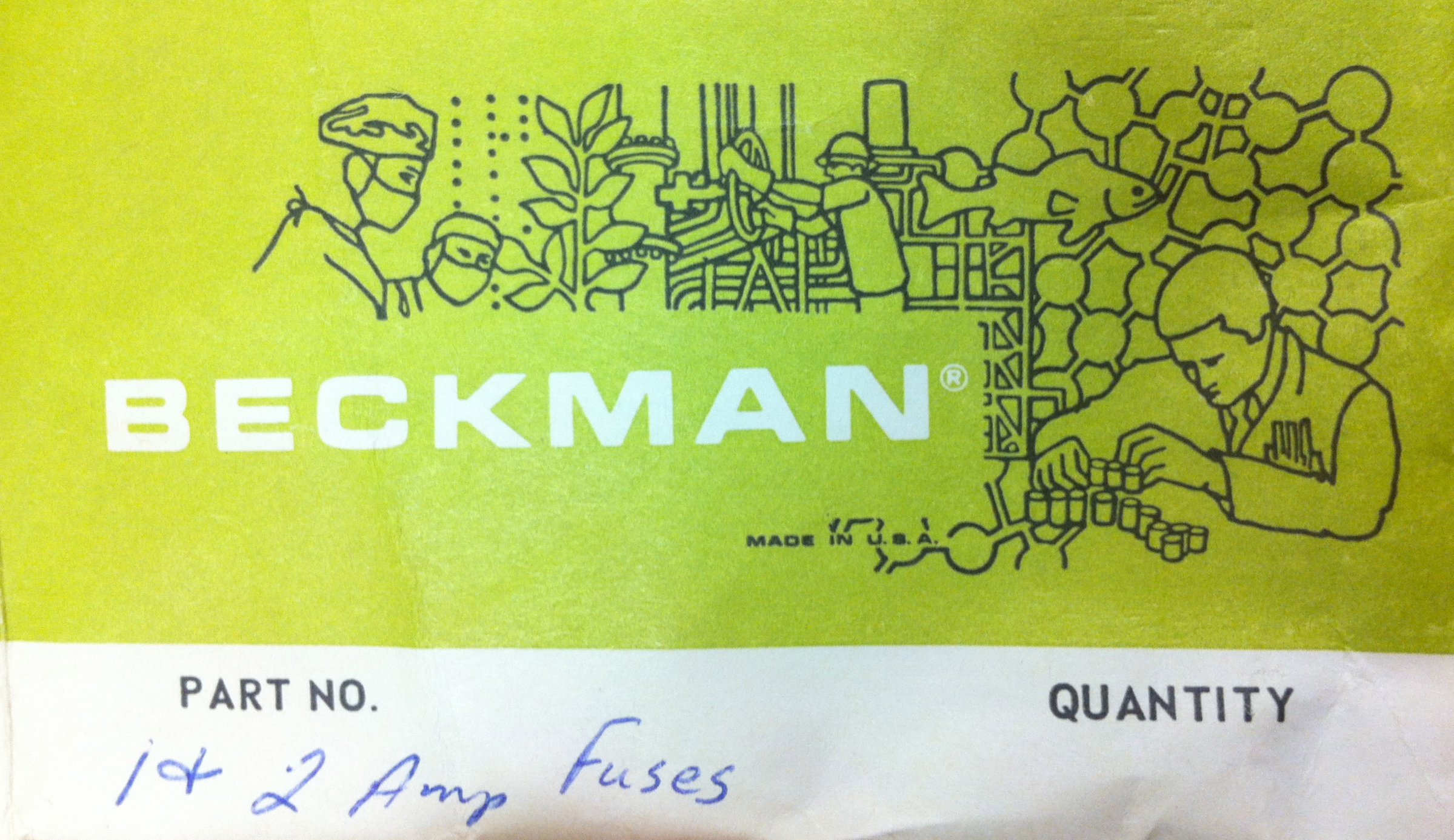
Mezes & Dakos
Happy Fourth! I hope you get to eat some good grilled food, dance among fireflies, and have your fair share of fireworks that aren’t your neighbors annoying second-rate cacophony of explosions tonight. Despite the first new curve analysis, which is promising (R2 = 0.998 for the lymphocyte protein curve, that is, what we think is in the samples, is in the samples), the THC project is currently on hold. There are high hopes of the new sample sets working with the ELISA enzyme assay kit, however due to unfortunate circumstances not all the necessary materials have arrived for round two (after all not every company can do -20°C overnight shipping like Sigma-Aldrich – it’s rather sketchy how that kind of transport it legal).
Spetsofai
Continue reading Off Quad Rule: Part 5
Off Quad Rule: Part 4
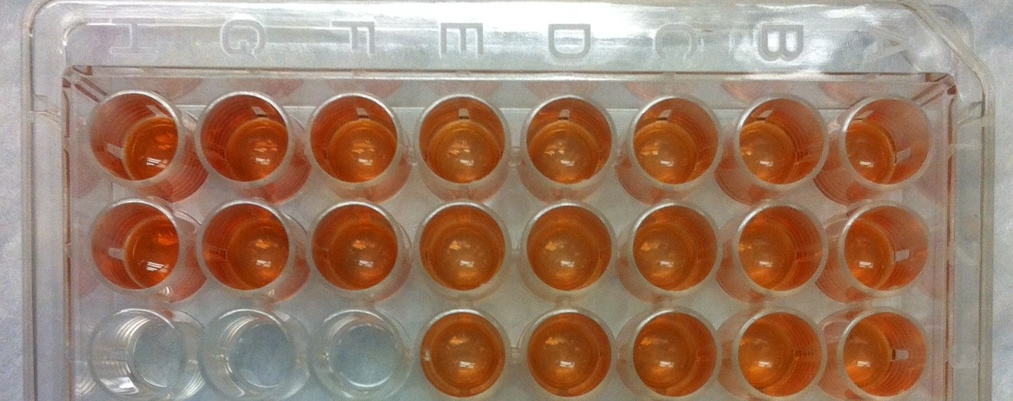
Mestouf
Another day another dollar, a new week a new protocol. I got to explore a revised protocol for harvesting lymphocytes from blood, which was as much fun as it was frustrating. I also got to learn a little about Rapamycin and its antibiotic properties – it happens to change the color of muscle from the typical fleshy red to a still very natural goldfish orange when applied to open wounds. I recently found a good centrifuge companion to fill the time when I actually have 30 minutes to spare during my busy day; Donna Tartt’s The Goldfinch has been a good read so far.
Continue reading Off Quad Rule: Part 4
Off Quad Rule: Part 3
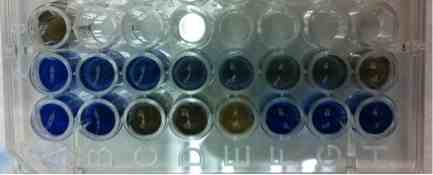
Suimono
This week started out great, with the Spurs winning on Sunday beating the Heat. Just when I thought my coworkers couldn’t be any happier or nicer, I am pleasantly surprised. The lab looks cleaner, the glassware is shining, and the hallways smell like victory in place of the familiar urine, iron, and formaldehyde-blended scents. This week I’ve been back and forth between two lab benches on opposite sides of the building, working on the preliminary data that measures the activity of cannabinoid receptors, specifically CB1 and CB2, in the collected lymphocytes.
Gyoza
Continue reading Off Quad Rule: Part 3
Off Quad Rule: Part 2

Tapas
The protein curve, calibration curve, and initial lymphocyte concentration results from last week came back and were excellent, or “acceptable” in research terms. A little more explanation (sans math, I won’t bore you): The protein curve is a plot that measures the concentration of protein loaded into a well of the plate vs. the optical density associated with it. This is determined by incubating the loaded well plates using a dye reagent, which will produce a distinct pigmentation for each protein concentration in the individual wells. Using colorimetry, protein concentration can be quantified by detecting differences in tint and give results based on a specific wavelength. The same goes for the calibration curve, however the purpose for this is to make sure the ELISA Assay kit works, and to make sure the person operating it knows how to properly use it. The initial lymphocyte concentration results are done to get an estimate of the typical concentration of lymphocytes in the blood samples, this is run in tandem – so to say – with the protein curve. This determines the lymphocyte concentrations relative to the known quantities, and depending on the dilution factors (10x and 100x in this case), also gives suggestions about whether or not to dilute samples. That was quite filling; I hope you’re still a little peckish after all that.
Paella y Sangria
Continue reading Off Quad Rule: Part 2
Off Quad Rule
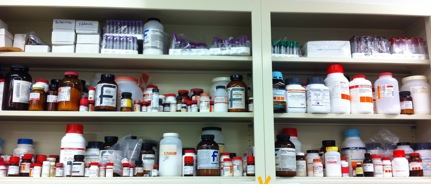
June 6, 2014
Hors d’oeuvre
Yours,
Emma (‘16)
That is how this first entry is going to end. At this point in time, that is one of only two things I’m sure of right now. The second is that I don’t want this blog to be mine. I want it to be yours to read, scroll through, be critical of, or figure out what to write to me about in your next letter to me, if I happen to be so fortunate. I’ll try to help you out as much as possible.
Consommè
Work carried out in that lab I am working in at the University of Texas Health Science Center at San Antonio (UTHSCSA) predominantly studies addiction and drug abuse in youth and adults. I will be examining the active component of Cannabis, tetrahydrocannabinol (THC), and any of its effects in cell signaling. I will try to suss out the implications this may have on locomotor and cognitive impairment from that point onward, referring to the data collected after running blood and lymphocyte samples. Explicitly, my aim in all of this is to provide information that is reliable in instructing those regulating, prescribing, and using marijuana, so that they may dispense and use it safely.
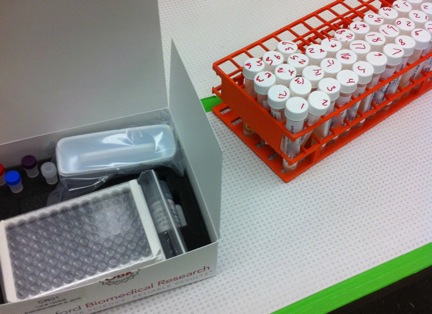
Continue reading Off Quad Rule
Daniel Lybrand, Wehrli Lab Notes, Post 3
My internship at OHSU has now ended, but fortunately not my partnership with the Wehrli lab. I will continue on as a research assistant for the next year before proceeding to graduate school and will hopefully help to advance the lab’s ongoing projects.
We have been making good progress towards understanding some of the mechanisms by which processes dependent on Wnt signaling are regulated. As mentioned earlier, fluorescence microscopy figures prominently in our research. Marcel has taken a somewhat non-traditional approach to fluorescence imaging for this project in order to skirt some issues peculiar to the Wnt pathway. This has largely paid off, but we are sometimes hindered by issues unrelated to the imaging techniques themselves: often, the biggest challenge we face comes from our research subjects before they are even dissected. While Drosophila are typically easy to care for, certain genetic constructs, pivotal to our research, have a disappointing effect on their survival rates. An experiment that seems very straightforward at the outset can be a laborious process as fly crosses are made and remade to yield the needed larvae. Despite all the resources that our fully functional lab has access to, research can come to a halt due to events beyond our control. Additionally, our latest observations from the confocal microscope may prompt us to reconsider what we’ve previously seen. We may want to revisit an experiment that seemed complete weeks or months ago.
Despite this apparent lack of progress, the pieces do eventually come together in some fashion. We may be thoroughly confused by our data on some days, but when Marcel sees what we’ve missed before, things begin to make sense. These are the “aha!” moments that scientists strive for. At these moments, I typically remain confused. Recognizing patterns can be hard. Understanding the implications of those patterns is harder. Some of our experiments give strong results that, on the surface, get us no closer to our quarry. These results may be the key to answering our questions if we can come to understand their significance. I look forward to the discovery.
Continue reading Daniel Lybrand, Wehrli Lab Notes, Post 3
Notes from a Paris Biology Lab, Presidents Summer Fellowship, Ch 2
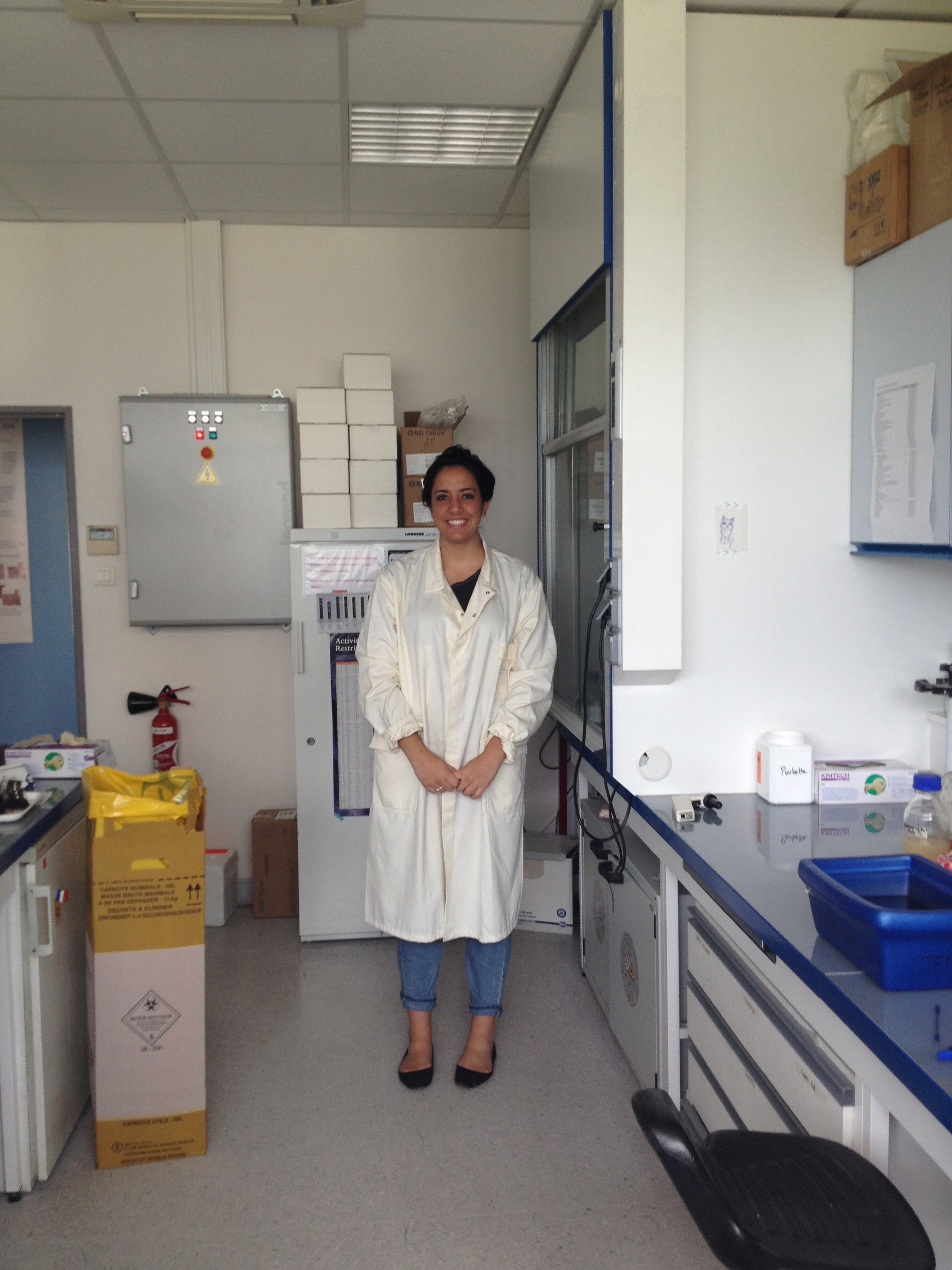
Lab notes
Hello! I am starting the beginning of my fourth week of my internship here in Paris! Wow, time goes by very quickly.
Today I read a great article called Disciplinarity: An Introduction by David R. Shumway and Ellen Messer-Davidow. It had a sweeping overview of the history of disciplinary education, and cited many of the current scholars of the transdisciplinary revolution that is catching on in academia. It was fascinating, and I hope to re-read it later tonight. I also did some research on William Whewell, a 19th c. polymath. He wrote on so many subjects that it is hard to get an idea of his character, but it is clear that he was an influential thinker in Britain. He is most well-known for his philosophy of science, history of science and moral philosophy (SEP). Some neat facts about him are that he coined the term "scientist," and that before him scientists were "called natural philosophers." Ha! The irony! I wonder how many scientists are aware of the philosophic implications behind their title…. Whewell was also very close to the influential scientists of his time. Darwin, Faraday and others would come to him to invent terms such as “anode,” “cathode,” and “ion” (those were invented for Faraday). Anyways, Whewell is someone who I hope to do more reading on. He seems like a great mind and his work is very pertinent to my studies.
Continue reading Notes from a Paris Biology Lab, Presidents Summer Fellowship, Ch 2
Wehrli Lab Notes, Daniel Lybrand '13
I am currently working at OHSU in the lab of Marcel Wehrli, Ph.D. The lab studies development in Drosophila (fruit flies) and focuses on the Wnt signaling pathway, one that features prominently in developmental biology research. My first week at OHSU has introduced me to a completely new area of biology. Most of my prior research experience has been in plant physiology. I have never worked with Drosophila before and know almost nothing about their development, so I am guaranteed to learn something new every day.
As a novice in the field, I learn from both Marcel and his research assistant, Misha (also a Reedie). I don’t yet have a project of my own, so I usually assist Misha with her experiments. Some of what I learn is completely new – techniques that I have never seen before.
In the past week, I have learned how to distinguish between male and female flies, how to tell a virgin from a fly that has never mated, how to dissect a fly larva, and how to identify the imaginal discs within the larva that eventually develop into various appendages. Other things are familiar but must be re-learned, as different labs carry out basic protocols in different ways. Antibody staining fruit fly larvae is very different from staining plant tissues!
Continue reading Wehrli Lab Notes, Daniel Lybrand '13
Notes from a Paris Biology Lab, Presidents Summer Fellowship
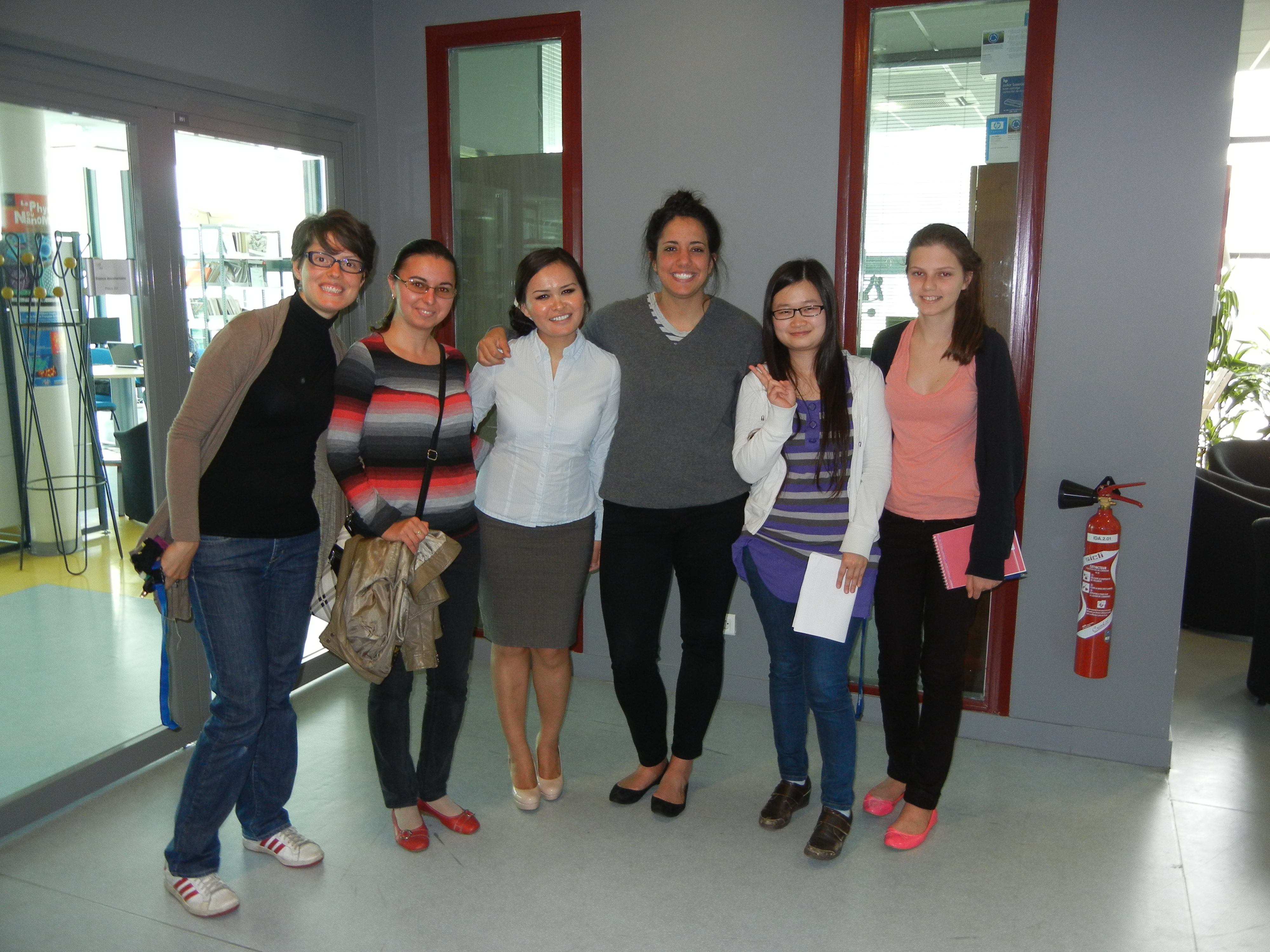
Maya with lab partners
This is the first of a series of blogs about the adventures of a Reed President's Summer Fellow. I am a student of philosophy learning the ropes of interdisciplinary studies for two months in Paris, France. I am focusing on the philosophic implications behind scientific research in a microbiology lab at ENS-Cachan led by Dr. Bianca Scalvi. The research at this lab is based on trying to understand the initiation of DNA replication.
I am neither a scientist, nor a philosopher. I am simply someone who wants to understand the way our society works. I have a background in chemistry, and spent a summer synthesizing organic compounds in a lab directed by Dr. Youngblood at UNT. That experience offers me an advantage in the microbiology lab. I am familiar with the environment of a laboratory and I am able to understand the basics of the research without too much trouble. My background in philosophy seems to have been with me since I was a child, yet I have only come to realize how much I enjoy the discipline when I started at Reed College two years ago. I have taken some courses in philosophy at Reed, and I try to approach each situation I find myself in with an open and philosophic mind.
Continue reading Notes from a Paris Biology Lab, Presidents Summer Fellowship
